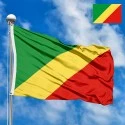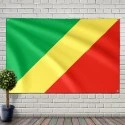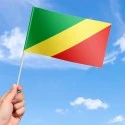The national flag of the Republic of the Congo is a vibrant and symbolically rich emblem that embodies the nation's journey towards independence, its deep connection to the African continent, and its aspirations for prosperity and a brighter future. Adopted on August 18, 1958, while the country was still an autonomous republic within the French Community, it was officially retained upon full independence on August 15, 1960. Its design elements are deeply rooted in Pan-African symbolism, reflecting the country's shared heritage and destiny with other African nations that emerged from colonial rule.
Design and Symbolism: A Tapestry of Pan-African Unity and National Identity
The flag of the Republic of the Congo features a diagonal band of yellow, starting from the lower hoist (left) side and extending to the upper fly (right) side. The upper triangle formed by this diagonal band is green, and the lower triangle is red. This unique design, while incorporating Pan-African colors, presents them in a distinctive diagonal arrangement. Each color carries profound symbolic meaning:
-
Green (Upper Triangle): The green triangle in the upper part of the flag symbolizes the abundant agricultural wealth, natural resources, and dense forests of the Republic of the Congo. It represents the country's rich biodiversity, its fertile lands, and the hope for a prosperous future built on sustainable development. Green also signifies hope and optimism for the nation's progress and well-being.
-
Yellow (Diagonal Band): The prominent yellow diagonal band, cutting across the flag, signifies friendship, nobility, and the sun that shines over the country. Yellow also represents the richness of the nation's natural resources, particularly its mineral wealth, and the prosperity that these resources are expected to bring. Its diagonal placement suggests dynamism and forward movement.
-
Red (Lower Triangle): The red triangle in the lower part of the flag is generally interpreted as symbolizing the struggle for independence and the sacrifices made by the people during the fight against colonial oppression. It evokes the blood shed by those who fought for the nation's freedom and their unwavering determination. Red is a powerful reminder of the nation's revolutionary past and its commitment to self-determination.
The combination of these Pan-African colors, arranged diagonally, creates a dynamic and modern visual identity while firmly placing the Republic of the Congo within the broader African liberation narrative.
Dimensions and Proportions:
The official proportions of the Flag of the Republic of the Congo are typically a width-to-length ratio of 2:3. The diagonal yellow band runs from the lower left corner to the upper right corner, effectively dividing the flag into two triangles. The precise dimensions and angles of the diagonal band are crucial to maintaining the visual balance and distinctive appearance of the flag. The green and red triangles, formed by this diagonal, are proportionate to each other and to the overall flag dimensions, ensuring a harmonious composition.
History and Evolution: From Colonial Emblems to National Pride
The history of the Republic of the Congo's flag is a reflection of its journey from colonial rule to a sovereign nation, marked by periods of political change and symbolic re-affirmation.
-
Colonial Period (Pre-1958): Prior to 1958, as part of French Equatorial Africa and later as the French Congo, the territory flew the flag of France. There were no distinct territorial flags during much of this period, and the French Tricolour served as the primary symbol of authority.
-
Autonomy and First Adoption (1958): The current flag was first adopted on August 18, 1958, when the French Middle Congo became an autonomous republic within the French Community, renaming itself the Republic of the Congo. The choice of Pan-African colors and the diagonal design was a conscious decision to express solidarity with other African nations achieving self-rule and to establish a distinct national identity separate from its colonial past. This marked a significant step towards full independence.
-
Full Independence (1960): When the Republic of the Congo gained full independence on August 15, 1960, the flag adopted in 1958 was retained as the national flag. This continuity underscored the stability of its chosen national symbols despite the transition to complete sovereignty.
-
Marxist Era and Replacement Flag (1969-1991): In 1969, following a period of political instability and the establishment of the People's Republic of the Congo under a Marxist-Leninist government, the flag was changed. The new flag of the People's Republic featured a red field (symbolizing the revolution) with a green wreath (representing hope and natural resources) and a yellow star (for socialism and unity) in the upper hoist corner. This flag reflected the ideological shift of the nation.
-
Re-adoption of the Original Flag (1991): With the end of the Cold War and the move towards multi-party democracy in Africa, the People's Republic of the Congo transitioned back to the Republic of the Congo. On June 10, 1991, the original 1958 flag was re-adopted. This re-adoption symbolized a return to its foundational principles, a rejection of the Marxist past, and a reaffirmation of its original national identity and aspirations for broader African unity.
Regional Context and African Identity:
The Republic of the Congo is located in Central Africa, bordered by the Democratic Republic of the Congo, Gabon, Cameroon, the Central African Republic, and Angola (Cabinda). Its flag is a prominent example of Pan-African flag design, utilizing the colors red, yellow, and green. These colors, first popularized by Ghana's flag upon its independence in 1957, became a potent symbol of African liberation, unity, and self-determination.
Many newly independent African nations adopted variations of these colors, often arranged in horizontal or vertical stripes. The Republic of the Congo's diagonal arrangement, however, gives its flag a unique visual dynamism while still clearly associating it with the broader Pan-African movement. It signifies the nation's shared destiny with other African countries in building a prosperous and independent continent, moving forward together from a history of colonialism. This design reinforces its identity as an integral part of the African continent and its commitment to continental solidarity.
Interesting Facts:
-
Pan-African Colors: The flag features the classic Pan-African colors (green, yellow, red), symbolizing African unity, liberation, and natural wealth.
-
Unique Diagonal Design: Unlike many other African flags, the Republic of the Congo's flag uniquely uses a diagonal band, giving it a distinctive appearance.
-
Early Adoption: It was one of the earliest flags incorporating Pan-African colors to be adopted by an African state, even before full independence.
-
Brief Replacement: The flag was replaced during the Marxist era (1969-1991) but was later re-adopted, marking a return to its original national identity.
-
Symbol of Continuity: Its re-adoption in 1991 signifies continuity with its pre-Marxist history and a commitment to democratic values.
-
Rich Natural Resources: The colors, particularly green and yellow, are strongly linked to the country's rich natural resources, including oil, timber, and minerals.
-
Located on the Equator: The Republic of the Congo lies on the Equator, making the "sun" symbolism of the yellow stripe particularly apt.
-
Not to be Confused: It is sometimes confused with the flag of the Democratic Republic of the Congo (DRC) due to similar colors, though the designs are quite different.
Significance for the Inhabitants: A Symbol of Resilience, Identity, and Aspiration
For the people of the Republic of the Congo, their national flag is more than just a piece of fabric; it is a powerful symbol of their resilience, shared identity, and collective aspirations. It embodies the sacrifices made by their forebears in the struggle for independence, a history that deeply resonates with generations. The red triangle serves as a poignant reminder of this past struggle, instilling pride in their hard-won freedom.
The green and yellow elements, representing the nation's natural abundance and potential for prosperity, offer hope for a brighter future. They signify the rich lands that sustain them and the economic development that is essential for improving their lives. The diagonal flow of the yellow stripe suggests a dynamic and forward-moving nation, reflecting the optimism and determination of the Congolese people to build a better tomorrow.
The flag is proudly displayed during national holidays, cultural events, and sporting competitions, fostering a strong sense of patriotism and national unity. It serves as a unifying symbol, transcending ethnic and regional differences and reminding all citizens of their shared heritage and common destiny. In schools, at public gatherings, and in homes, the flag stands as a constant beacon of what the Republic of the Congo represents: a sovereign nation, deeply connected to its African roots, striving for peace, prosperity, and a harmonious future for all its inhabitants. It is a source of immense pride, reminding them of who they are as a people and what they can achieve together.
In the demonstration images, full-size flags are shown with proportions of 2:3, and hand-held flags with proportions of 1:2.






 Waving flag
Waving flag
 Sizes:
Sizes:
 Round flag
Round flag
 Sizes:
Sizes:
 Rectangular flag 2:3
Rectangular flag 2:3
 Sizes:
Sizes: